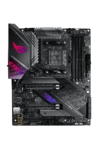unbuildpain
Full Member level 2
What is the purpose of squiggly traces? These can be noticed between the CPU socket and RAM sockets in the following photo:
They hardly seem to cause any delay, so why? They appear very similar to the antenna patterns of USB adapters, can these also emit signals?

They hardly seem to cause any delay, so why? They appear very similar to the antenna patterns of USB adapters, can these also emit signals?
